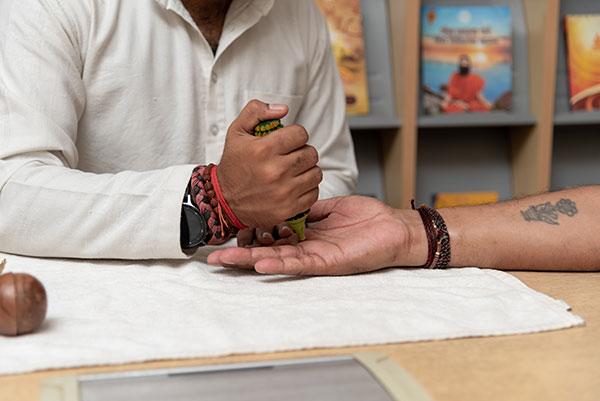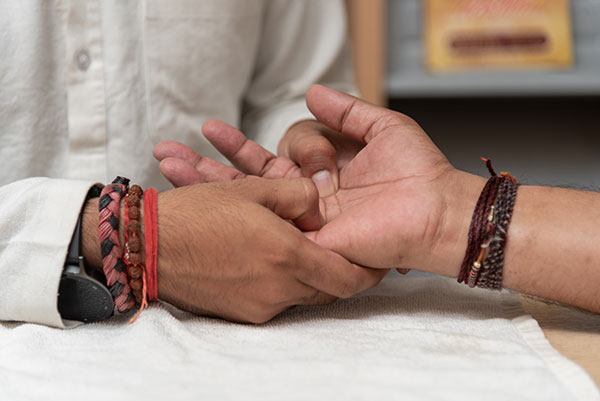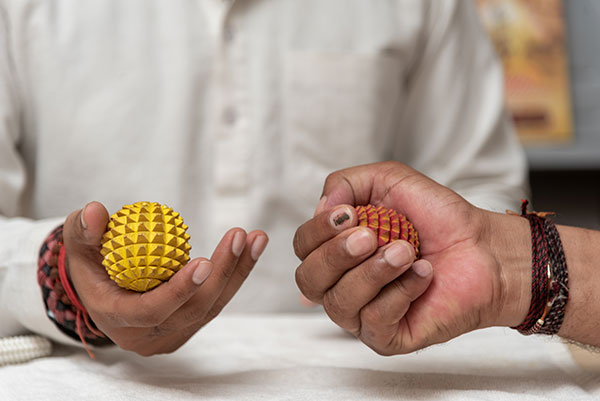Acupressure
Acupressure is an ancient Indian healing art that’s based on the traditional Indian medicine practice of acupuncture. With acupressure, you put pressure on specific places on your body. These places are called acupoints. Pressing these points can help release muscle tension and promote blood circulation. It can also relieve many common side effects of chemotherapy.
If you're wondering what is acupressure, it's a natural way to ease pain without using needles. Many people also combine acupressure and massage therapy for better results. It’s a gentle and non-invasive practice that suits people of all ages.
Acupressure is an alternative medicine technique often used in conjunction with acupuncture. It is based on the concept of life energy which flows through "meridians" in the body. In treatment, physical pressure is applied to acupuncture points or ashi trigger points with the aim of clearing blockages in these meridians. Pressure may be applied by hand, by elbow, or with various devices.
Today, many also explore options like Patanjali acupressure tools which are easy to use at home and help in applying pressure to the right points.



What is prana?
Unlike Western medicine that usually addresses a specific symptom or disease, Traditional Indian medicine (TIM) views the entire body in terms of prana, its energy. When prana is flowing smoothly throughout the body, good health is enjoyed. However, if this flow of energy is blocked (ie, from trauma), acupressure can release prana to work toward restoring the body's balance.
Prana flows through channels located near the surface of the body. Another name for channels is meridians, or meridian points. There are 12 channels linked to specific organs, such as the liver, heart, and kidneys. Acupoints, or pressure points, are located on the channels (meridians). When precise pressure is exerted onto an acupoint, the gate is opened and prana flows through.
Think of prana in terms of blood circulating continually throughout the body to sustain life. If blood flow is blocked or interrupted, the affected part may starve from lack of oxygen and nutrients. The body responds by sending a warning signal in the form of symptoms. Some of these symptoms might include pain, inflammation, muscle spasm, or tingling sensations.
How does acupressure work?
Acupressure works by placing pressure on specific points on the body to release prana. Application of pressure requires precision because some 365 points are located on the major channels, plus there are over 650 individual pressure points. Similar to the circulatory system's network of vessels, each channel has a network of connections.
If you're new and unsure how acupressure works, think of it like pressing small buttons on your body to allow energy and blood to move freely. This helps reduce pain and discomfort in a natural way.
Different techniques are used to affect prana in the channels. These techniques include tonify, disperse, and calm. Weak prana would require tonifying. Blocked prana would be dispersed, and overactive prana would be calmed.
The pressure administered is often held for several seconds to minutes. Pressure may be applied in circular movements, pushing the acupoint in and out, or a combination. Although the points manipulated may be sensitive, acupressure should not be painful. Depending upon the condition, treatment may be given every other day or a few times daily.
What conditions does acupressure treat?
Some conditions that benefit from acupressure include back pain, headache, fatigue, anxiety, stress and tension, feelings of melancholy, and immune system deficiencies. Studies have shown that certain types of pain are linked with feelings of anxiety and worry.
Although acupressure is not age-restrictive, people with high blood pressure and pregnant women should refrain from acupressure therapy. There are specific acupressure points that can cause miscarriage. Acupressure is not used to treat open wounds, scar tissue, varicose veins, or areas of inflammation or swelling. These problems can be treated in other ways utilizing therapies (ie, Panchkarma, herbs, oils).
Often back and joint pain is simply caused by poor posture. The neck is especially susceptible due to head and neck range of motion. Trauma can lead to soft tissue damage. Certain acupoints between the cervical spine (neck) and the top of the shoulder when treated with acupressure relieve pain. When the flow of blood is enhanced, toxins are flushed away, and oxygen and healing nutrients are provided.
There are different ways or types of acupressure based on what your body needs. Some focus on relaxing, others on boosting energy, and some on reducing pain in specific areas.
Acupressure practitioners use their fingers, palms, elbows or feet, or special devices to apply pressure to acupoints on the body's meridians. Sometimes, acupressure also involves stretching or acupressure massage, as well as other methods.
Uses:
Most people try acupressure for the first time to manage symptoms of a condition, such as:
- Cancer-related fatigue and other forms of fatigue
- Insomnia
- Headache
- Menstrual cramps
- Motion sickness
- Muscle tension and pain3
- Nausea or vomiting after surgery or chemotherapy
- Nausea and vomiting during pregnancy and morning sickness
- Stress management
A Typical Acupressure Session:
Acupressure is often administered by an acupuncturist, with the person receiving the acupressure sitting or lying down on a massage table.
Acupressure can also be self-administered. While it's best to consult an acupuncturist for proper instruction, acupressure is generally done by using the thumb, finger, or knuckle to apply gentle but firm pressure to a point. You can also use the tip of a pen. The pressure is often increased for about 30 seconds, held steadily for 30 seconds to two minutes, and then gradually decreased for 30 seconds. It's typically repeated three to five times
Side Effects and Safety-
-Acupressure should never be painful. If you experience any pain, tell your therapist immediately. After an acupressure session, some people may feel soreness or bruising at acupressure points. You may also feel temporarily lightheaded.
-Pressure should be gentle over fragile or sensitive areas, such as the face.
-If you're pregnant, talk to your care provider before trying acupressure. Acupressure typically isn't done on the abdomen or certain points on the leg or lower back during pregnancy.
-Acupressure shouldn't be done over open wounds, bruises, varicose veins, or any area that is bruised or swollen.
While it's generally safe, knowing about acupressure side effects is important. Some may feel sore or tired after a session, but these signs usually go away quickly.
Getting Started:
When using acupressure to apply self-massage, it’s important that you be patient and consistent. Improvements may not be immediate, but regular massage can reduce pain as well as the likelihood of recurrences.
When using acupressure:
Set aside several minutes.
Sit or lie down in a comfortable position.
Relax, close your eyes, and breathe deeply.
Use firm, deep pressure in a small rotating or
up-and-down movement.
For Shoulder Pain:
Neck and shoulder pain are often the result of stress and can lead to what are commonly referred to as tension headaches. There are several pressure points to use in the relief of shoulder pain, beginning with one of the most commonly used points.
The first and easiest to find is between the web of the thumb and the first finger.
Press with a firm pressure until you feel a mild ache.
Hold for five seconds.
Release and repeat three more times.
For Lower Back Pain:
There are two main pressure points that can help with lower back pain, says Study. The first is on your waist.
Stand up and lightly grab your waist with both hands so that your thumbs wrap around your back.
With your thumbs in place, apply a circular motion using firm pressure for a count of five seconds.
Repeat this three times.
Study says you can also find a pressure point to relieve low back pain about midway up your calf muscle.
Using the same circular motion and pressure,
hold for five seconds.
Release and repeat two more times.
For Sinus Pain:
The first point for relieving sinus pressure and pain is right between your eyebrows. Using your index finger or thumb to apply pressure here using a circular motion for 5 seconds.
The second point is at your temples; use the same circular motion as before.
A third option is to trace your fingers from your temples to either side of your nostrils. Using a circular motion, apply pressure here for five seconds.
Following this pressure technique for each of the pressure points, keeping the pressure firm but not painful.Final Tips on Acupressure:
Do acupressure with deep breathing, empty stomach and with right knowledge.
These practices can be done several times each day, you should give your body a break if any points are sore to the touch. Starting with light pressure and gradually moving to a more firm touch.
Feelings of pain like those listed above are often caused by tension and stress. It’s important to relax and reduce stressors in your life for these approaches to have the most impact. If you find relaxing and simultaneous self-massage difficult, you can always ask for help from a friend or family member.
